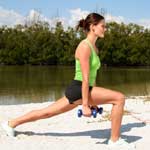If you are physically fit, you are free from illness, and able to function efficiently and effectively, to enjoy leisure, and to cope with emergencies.
Physical fitness is a general state of health and well-being or specifically the ability to perform aspects of sports or occupations.
Physical fitness is generally achieved through correct nutrition, exercise, hygiene and rest. It is a set of attributes or characteristics that people have or achieve that relates to the ability to perform physical activity.
Physical fitness combines good health and physical development.
The object of any program of physical fitness is to maximize an individual’s health, strength, endurance, and skill relative to age, sex, body build, and physiology.
These ends can only be realized through conscientious regulation of exercise, rest, diet, and periodic medical and dental examinations.
Exercise should be regular and vigorous, but begun slowly and only gradually increased in strenuousness.
Popular exercise methods include jogging, cycling, and the use of body-building machines.
It is more important that periods of sleep be regular and restful than that they extend any fixed number of hours.
A properly balanced diet in proteins, carbohydrates, vitamins, and minerals is essential.
Complete and regular physical examinations should be the basis of any program of physical development.
Although sports are related to physical fitness, care must be taken that injuries do not occur, and that the skin is adequately protected against the cancerous effects of solar radiation.
For physical-fitness exercises are generally grouped into three types, depending on the overall effect they have on the human body:
1. Aerobic exercise:
Aerobic exercise is any physical activity that uses large muscle groups and causes your body to use more oxygen than it would while resting.
The goal of aerobic exercise is to increase cardiovascular endurance.
Examples of aerobic exercise include cycling, swimming, brisk walking, skipping rope, rowing, hiking, playing tennis, continuous training, and long slow distance training.
2. Anaerobic exercise:
Anaerobic exercise is also called strength or Resistance training and can firm, strengthen, and tone your muscles, as well as improve Bone strength, Balance, and Coordination.
Examples of strength moves are pushups, lunges, and bicep curls using dumbbells.
Anaerobic exercise also include weight training, functional training, eccentric training, Interval training, sprinting and high-intensity interval training increase short-term muscle strength.
3. Flexibility exercise:
Flexibility exercises stretch and lengthen your muscles.
Activities such as stretching help to improve joint’s flexibility and keep muscles limber.
The goal is to improve the range of motion which can reduce the chance of injury.
